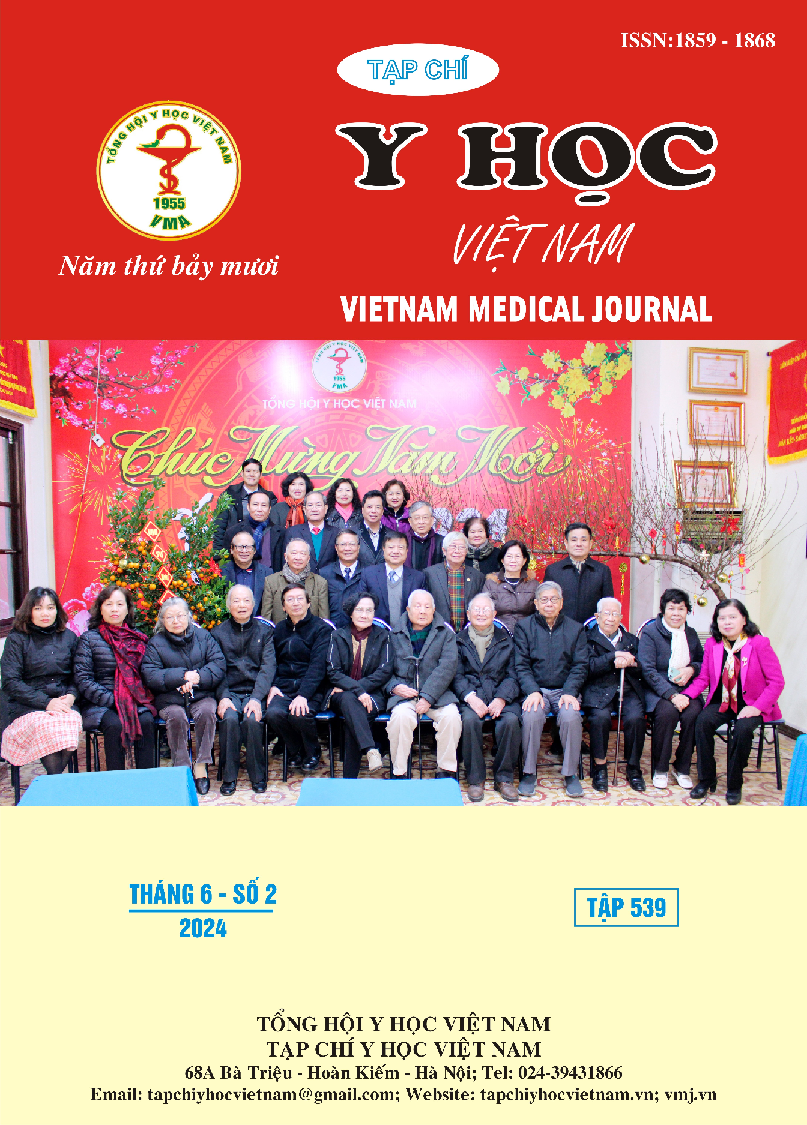CLINICAL CHARACTERISTICS AND CARDIAC MAGNETIC RESONANCE IMAGING OF PATIENTS WITH NON-COMPACTION CARDIOMYOPATHY AT HANOI MEDICAL UNIVERSITY HOSPITAL
Main Article Content
Abstract
Purpose: Describe clinical characteristics and cardiac magnetic resonance imaging (MRI) of patients with non-compaction cardiomyopathy at Hanoi Medical University Hospital. Material and methods: Descriptive study conducted at Hanoi Medical University Hospital from June 2022 to June 2023 on patients with non-compaction cardiomyopathy, having cardiac magnetic resonance imaging at Hanoi medical university. Results: There were 3 patients with a mean age of 35.6±10.2; including of 2 female patients and 1 male patient. 2 patients had shortness of breath, 1 patients had no symptom. All 3 patients had arrhythmia among them 2 patients had left bundle branch block, 1 patient had ventricular extrasystoles. On MRI, all 3 patients had left ventricular non-compaction cardiomyopathy, mainly found in the middle and apex area, NC/C ratio of 4.5 ± 2.9. 1 patient had decreased ejection fraction. No one had the late myocardial enhancement. Conclusion: Cardiac magnetic resonance imaging was an important non-invasive imaging method in the diagnosis of non-compaction cardiomyopathy.
Article Details
Keywords
non-compaction cardiomyopathy, cardiac magnetic resonance, NC/C ratio.
References
2. Jenni R, Goebel N, Tartini R, Schneider J, Arbenz U, Oelz O. Persisting myocardial sinusoids of both ventricles as an isolated anomaly: Echocardiographic, angiographic, and pathologic anatomical findings. Cardiovasc Intervent Radiol. 1986; 9(3):127-131. doi: 10.1007/BF02577920
3. Ro B. Report of the WHO/ISFC task force on the definition and classification of cardiomyopathies. Heart. 1980; 44(6): 672-673. doi:10.1136/ hrt.44.6.672
4. Engberding R, Bender F. Identification of a rare congenital anomaly of the myocardium by two-dimensional echocardiography: persistence of isolated myocardial sinusoids. Am J Cardiol. 1984; 53(11): 1733-1734. doi: 10.1016/0002-9149(84) 90618-0
5. Maron BJ, Towbin JA, Thiene G, et al. Contemporary definitions and classification of the cardiomyopathies: an American Heart Association Scientific Statement from the Council on Clinical Cardiology, Heart Failure and Transplantation Committee; Quality of Care and Outcomes Research and Functional Genomics and Translational Biology Interdisciplinary Working Groups; and Council on Epidemiology and Prevention. Circulation. 2006;113(14):1807-1816. doi:10.1161/CIRCULATIONAHA.106.174287
6. Ritter M, Oechslin E, Sütsch G, Attenhofer C, Schneider J, Jenni R. Isolated Noncompaction of the Myocardium in Adults. Mayo Clin Proc. 1997;72(1):26-31. doi:10.4065/72.1.26
7. Engberding R, Stöllberger C, Schneider B, Nothnagel D, Fehske W, Gerecke BJ. Abstract 14769: Heart Failure in Noncompaction Cardiomyopathy - Data from the German Noncompaction Registry (ALKK). Circulation. 2012;126(suppl_21):A14769-A14769. doi:10.1161/circ.126.suppl_21.A14769
8. Gerecke BJ, Stoellberger C, Schneider B, Fehske W, Nothnagel D, Engberding R. Abstract 11978: Arrhythmias in Isolated Noncompaction Cardiomyopathy Data From the German Noncompaction Registry (ALKK). Circulation. 2011;124(suppl_21):A11978-A11978. doi:10.1161/circ.124.suppl_21.A11978
9. Paterick TE, Tajik AJ. Left Ventricular Noncompaction. Circ J. 2012;76(7):1556-1562. doi:10.1253/circj.CJ-12-0666
10. Grothoff M, Pachowsky M, Hoffmann J, et al. Value of cardiovascular MR in diagnosing left ventricular non-compaction cardiomyopathy and in discriminating between other cardiomyopathies. Eur Radiol. 2012; 22(12):2699-2709. doi:10.1007 /s00330-012-2554-7


